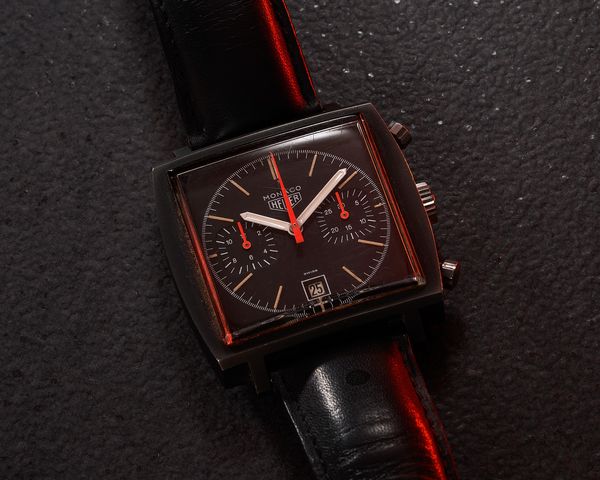- By Nicholas Biebuyck, Heritage Director at TAG Heuer
When the Monaco made its debut on the 3rd of March 1969, it looked like a vision of the future. Its blue iridescent dial that felt alive when it captured the light, brutalist angular case featuring its mixture of brushed and polished surfaces, stark rectangular hour and minute hands, and, when fitted to the bracelet, a sleek integrated look that was refreshing and modern, must of have given the impression of an alien spaceship landing in a retailer’s cabinet, especially when displayed alongside more traditional watch designs.
Yet less than a decade later, the Monaco transitioned from a sign of vitality and innovation for the Swiss watch industry as the vehicle to launch the landmark Calibre 11 automatic chronograph movement, into a nearly all black rendition that reflected the psyche of those working on the project, where the future was not so bright when viewed from the watchmaking heart of the world.
A number of external factors would contribute to the situation, namely the arrival of the Quartz Crisis, the so-called Nixon shock and the introduction of free-floating fiat currencies causing volatility between the Swiss Franc and the US dollar (a key market for a brand like Heuer), as well as wider socioeconomic turmoil through the oil crises and global conflicts leading to recession and stagflation.
But one of the bigger challenges for the Monaco was simply the fact that it was too avant-garde. While creative visionaries including Stanley Kubrick and Sammy Davis Jr. and Oscar Peterson would adopt the Monaco as a loyal companion, for the wider market it was too big a leap forward in terms of design. By 1975 the Monaco was appearing in a close out sale brochure and in 1976 it disappeared from the catalogue, replaced by the Heuer Silverstone.
With all of these factors in mind, it appears all the more curious that some time in the second half of the 1970s a new variation of the Monaco was made in extremely small quantities with a very different aesthetic. With its austere black finished case (done using chromium oxide treatment - not the PVD we know today), flat black dial devoid of steps for the subsidiary dials with just a hint of vibrant orange, and fitted with a manual wind Valjoux 7740 two register chronograph movement with date, the reference 74033N was about as far from the original reference 1133 launched in 1969 as one can imagine.
The enigmatic nature of the watch is what makes it so special today. Extremely small quantities were made, probably in the region of hundreds, although very few survived in good condition as the case finish wears easily. The model never appeared in
commercial catalogue, and they have managed to surface all over the world without a clear explanation or pattern to their distribution.
Today the original black Monaco not only foreshadowed the craze for black watches in the modern era but has also provided no shortage of inspiration for contemporary references at TAG Heuer. Be it the entry to Only Watch in 2021, the version created in partnership with Bamford Watch department, references for the Hour Glass and the Automobile Club de Monaco as well as future creations from the maison, all can trace their lineage back this little produced inexplicable reference from nearly 50 years ago.
The mystery of the black Monaco and how it came to exist remains unsolved in its entirety today creating no shortage of debate among collectors, but what can be agreed upon is the captivating nature of the piece. Its rarity, combined with the challenge of finding a genuinely great example, the iconic silhouette of the Monaco case form, and the fact that its stealthy military-esque appearance actually draws more attention to the watch in some situations, makes it among the most desirably
vintage Heuer watches, a true grail.
